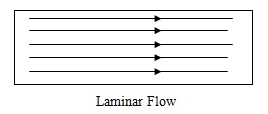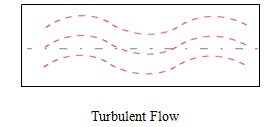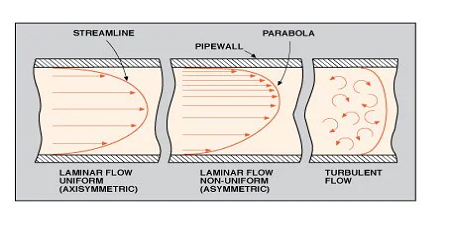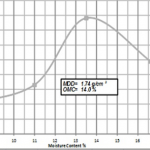Introduction
Generally, in fluid mechanics, fluid flow are classified into the following:
- Rotational and Irrotational Flows
- Steady and Unsteady Flows
- Compressible and Incompressible Flows
- One, Two, and Three Dimensional Flows
- Uniform and Non-Uniform Flows
- Laminar and Turbulent Flow
In this section, laminar and turbulent flows will be discussed.
Laminar flow is a type of flow in which the paths followed by individual particles do not cross one another. This flow is also called viscous flow. Laminar flow generally happens when dealing with small pipes and low flow velocities. Laminar flow can be regarded as a series of liquid cylinders in the pipe, where the innermost parts flow the fastest, and the cylinder touching the pipe isn’t moving at all. Examples of laminar flows include:
- Ground Water Flow,
- Flow of blood through veins and arteries,
- Flow through capillary tubes, etc

In turbulent flow, the fluid particles move in a zigzag manner as shown below. In turbulent flow, vortices, eddies and wakes make the flow unpredictable. Turbulent flow happens in general at high flow rates and with larger pipes.

A careful inspection of flow in a pipe reveals that the fluid flow is streamlined at low velocities but turns chaotic as the velocity is increased above a critical value. The flow regime in the first case is said to be laminar, characterized by smooth streamlines and highly ordered motion, and turbulent in the second case, where it is characterized by velocity fluctuations and highly disordered motion.
Transitional flow is a mixture of laminar and turbulent flow, with turbulence in the center of the pipe, and laminar flow near the edges. The process of a laminar flow becoming turbulent is known as laminar–turbulent transition. This is an extraordinarily complicated process, which at present is not fully understood. However, as the result of many decades of intensive research, certain features have become gradually clear, and it is known that the process proceeds through a series of stages. “Transitional flow” can refer to transition in either direction, that is, laminar–turbulent transitional or turbulent–laminar transitional flow.
The transition from laminar to turbulent flow does not occur suddenly; rather, it occurs over some region in which the flow fluctuates between laminar and turbulent flows before it becomes fully turbulent. Most flows encountered in practice are turbulent. Laminar flow is encountered when highly viscous fluids such as oils flow in small pipes or narrow passages.
To verify the existence of these laminar, transitional, and turbulent flow regimes, some dye streaks is injected into the flow in a glass pipe, as the British engineer Osborne Reynolds (1842–1912) did in 1883. We observe that the dye streak forms a straight and smooth line at low velocities when the flow is laminar (we may see some blurring because of molecular diffusion), has bursts of fluctuations in the transitional regime, and zigzags rapidly and randomly when the flow becomes fully turbulent. These zigzags and the dispersion of the dye are indicative of the fluctuations in the main flow and the rapid mixing of fluid particles from adjacent layers.
Results from Reynolds’ Experiment
After exhaustive experiments in the 1880s, Osborne Reynolds discovered that the flow regime depends mainly on the ratio of inertial forces to viscous forces in the fluid. This ratio is called the Reynolds number (Re) and is expressed for internal flow in a circular pipe as

Where
Vavg = average flow velocity (m/s)
D = characteristic length of the geometry (diameter in this case, in m)
u = m/ ρ = kinematic viscosity of the fluid (m2/s).
From the equation above, it should be noted that the Reynolds number is a dimensionless quantity.
Reynolds’ publications in fluid dynamics began in the early 1870s. His final theoretical model published in the mid-1890s is still the standard mathematical framework used today.
Classification Based on Reynolds Number
- For Reynolds’ Number Re < 2300, flow is laminar
- For Reynolds’ Number Re > 4000, flow is turbulent
- For Reynolds’ Number Re between 2300 and 4000, flow is in transition.
References
- Cengel, Y.A. and Cimbala, J.M. (2006). ‘Fluid Mechanics: Fundamentals and Applications’.
- Engineering ToolBox. ‘Laminar, Transitional or Turbulent Flow’ https://www.engineeringtoolbox.com/laminar-transitional-turbulent-flow-d_577.html. Assessed on March 2, 2018.
- Rajput R.K. (2013). ‘Fluid Mechanics and Hydraulic Machines’ S. Chand & Company Ltd, Ram Nagar, New Delhi.
- Wikipedia. “Laminar-turbulent Transition”. http://en.wikipedia.org/wiki/Laminar-turbulent_transition. Assessed on March 2, 2018.
Download “Study of Laminar, Turbulent and Transition Flows”
Study-of-Laminar-Turbulent-and-Transition-Flow.docx – Downloaded 0 times – 258.78 KB






